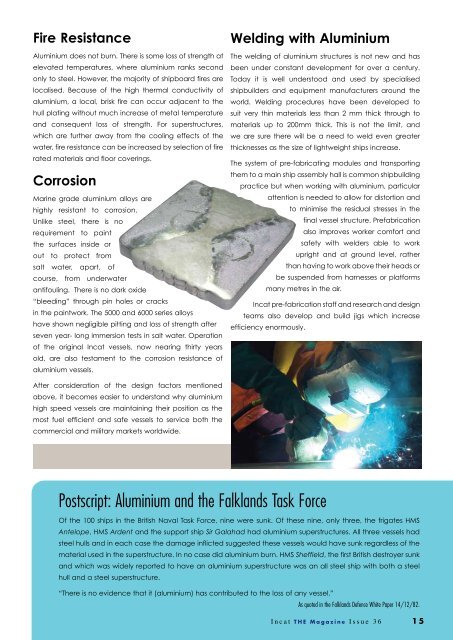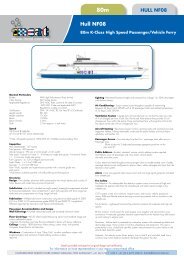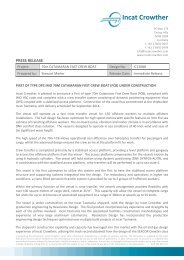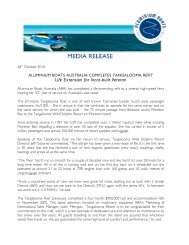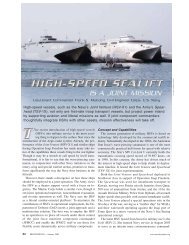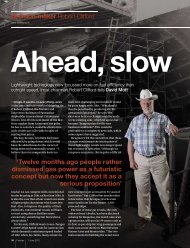US NAVY'S - Incat
US NAVY'S - Incat
US NAVY'S - Incat
Create successful ePaper yourself
Turn your PDF publications into a flip-book with our unique Google optimized e-Paper software.
Fire Resistance<br />
Aluminium does not burn. There is some loss of strength at<br />
elevated temperatures, where aluminium ranks second<br />
only to steel. However, the majority of shipboard fires are<br />
localised. Because of the high thermal conductivity of<br />
aluminium, a local, brisk fire can occur adjacent to the<br />
hull plating without much increase of metal temperature<br />
and consequent loss of strength. For superstructures,<br />
which are further away from the cooling effects of the<br />
water, fire resistance can be increased by selection of fire<br />
rated materials and floor coverings.<br />
Corrosion<br />
Marine grade aluminium alloys are<br />
highly resistant to corrosion.<br />
Unlike steel, there is no<br />
requirement to paint<br />
the surfaces inside or<br />
out to protect from<br />
salt water, apart, of<br />
course, from underwater<br />
antifouling. There is no dark oxide<br />
“bleeding” through pin holes or cracks<br />
in the paintwork. The 5000 and 6000 series alloys<br />
have shown negligible pitting and loss of strength after<br />
seven year- long immersion tests in salt water. Operation<br />
of the original <strong>Incat</strong> vessels, now nearing thirty years<br />
old, are also testament to the corrosion resistance of<br />
aluminium vessels.<br />
Welding with Aluminium<br />
The welding of aluminium structures is not new and has<br />
been under constant development for over a century.<br />
Today it is well understood and used by specialised<br />
shipbuilders and equipment manufacturers around the<br />
world. Welding procedures have been developed to<br />
suit very thin materials less than 2 mm thick through to<br />
materials up to 200mm thick. This is not the limit, and<br />
we are sure there will be a need to weld even greater<br />
thicknesses as the size of lightweight ships increase.<br />
The system of pre-fabricating modules and transporting<br />
them to a main ship assembly hall is common shipbuilding<br />
practice but when working with aluminium, particular<br />
attention is needed to allow for distortion and<br />
to minimise the residual stresses in the<br />
final vessel structure. Prefabrication<br />
also improves worker comfort and<br />
safety with welders able to work<br />
upright and at ground level, rather<br />
than having to work above their heads or<br />
be suspended from harnesses or platforms<br />
many metres in the air.<br />
<strong>Incat</strong> pre-fabrication staff and research and design<br />
teams also develop and build jigs which increase<br />
efficiency enormously.<br />
After consideration of the design factors mentioned<br />
above, it becomes easier to understand why aluminium<br />
high speed vessels are maintaining their position as the<br />
most fuel efficient and safe vessels to service both the<br />
commercial and military markets worldwide.<br />
Postscript: Aluminium and the Falklands Task Force<br />
Of the 100 ships in the British Naval Task Force, nine were sunk. Of these nine, only three, the frigates HMS<br />
Antelope, HMS Ardent and the support ship Sir Galahad had aluminium superstructures. All three vessels had<br />
steel hulls and in each case the damage inflicted suggested these vessels would have sunk regardless of the<br />
material used in the superstructure. In no case did aluminium burn. HMS Sheffield, the first British destroyer sunk<br />
and which was widely reported to have an aluminium superstructure was an all steel ship with both a steel<br />
hull and a steel superstructure.<br />
“There is no evidence that it (aluminium) has contributed to the loss of any vessel.”<br />
As quoted in the Falklands Defence White Paper 14/12/82.<br />
<strong>Incat</strong> THE Magazine Issue 36 15


